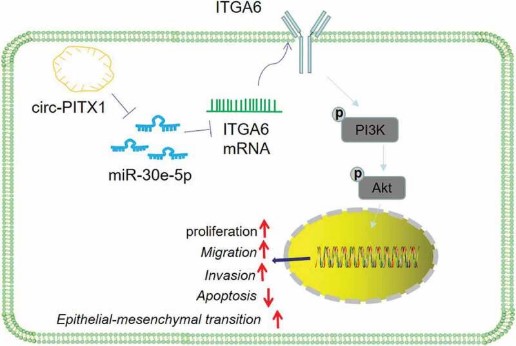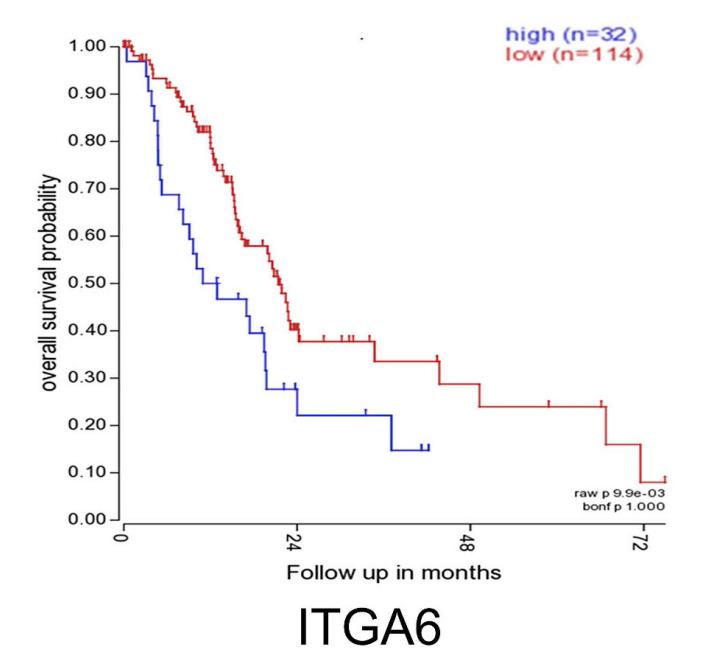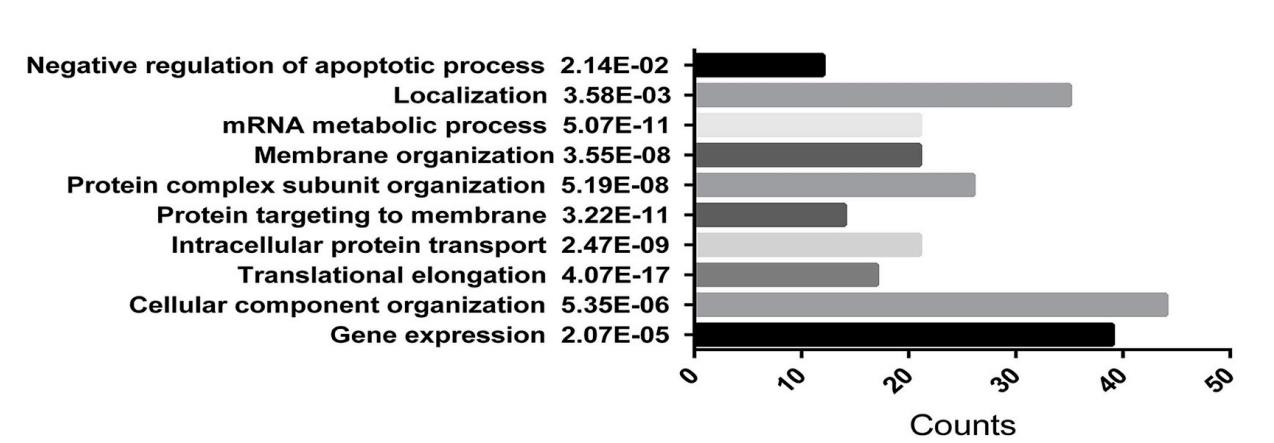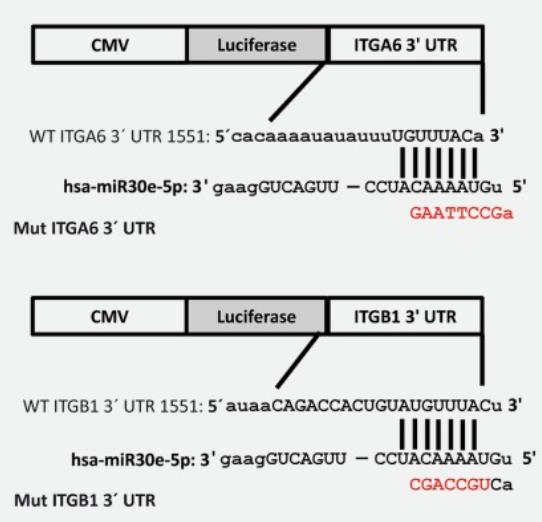ITGA6
-
Official Full Name
integrin, alpha 6 -
Overview
The ITGA6 protein product is the integrin alpha chain alpha 6. Integrins are integral cell-surface proteins composed of an alpha chain and a beta chain. A given chain may combine with multiple partners resulting in different integrins. For example, alpha 6 may combine with beta 4 in the integrin referred to as TSP180, or with beta 1 in the integrin VLA-6. Integrins are known to participate in cell adhesion as well as cell-surface mediated signalling. Two transcript variants encoding different isoforms have been found for this gene. -
Synonyms
ITGA6;integrin, alpha 6;integrin alpha-6;CD49f;integrin alpha6B;CD49 antigen-like family member F;VLA-6;ITGA6B;FLJ18737;DKFZp686J01244
Recombinant Proteins
- Human
- Rhesus macaque
- Mouse
- Chicken
- Human Cells
- E.coli
- CHO
- Mammalian Cells
- Wheat Germ
- HEK293
- In Vitro Cell Free System
- Flag
- His
- Non
- GST
- ABP
- DDK
- Myc
- Avi
- Fc
| Cat.# | Product name | Source (Host) | Species | Tag | Protein Length | Price |
|---|---|---|---|---|---|---|
| ITGA6-4115H | Recombinant Human ITGA6, flag & His tagged | Human Cells | Human | Flag&His | 1-1011;1-728 a.a. | |
| ITGA6-3016H | Recombinant Human ITGA6 protein, His-tagged | E.coli | Human | His | 477-690 aa | |
| ITGA6-4110H |
Active Recombinant Human ITGA6
|
CHO | Human | Non |
|
|
| ITGA6-609H |
Active Recombinant Human ITGA6
|
CHO | Human | Non |
|
|
| ITGA6-2314R | Recombinant Rhesus monkey ITGA6 Protein, His-tagged | Mammalian Cells | Rhesus macaque | His |
|
|
| ITGA6-4111H | Recombinant Human ITGA6, GST-tagged | Wheat Germ | Human | GST | 24 a.a. - 133 a.a. |
|
| Itga6-6767M | Recombinant Mouse Itga6 protein, His & GST-tagged | E.coli | Mouse | GST&His | Glu903~Ala1073 |
|
| ITGA6-6841C | Recombinant Chicken ITGA6 | Mammalian Cells | Chicken | His |
|
|
| ITGA6-5131HCL | Recombinant Human ITGA6 293 Cell Lysate | HEK293 | Human | Non |
|
|
| ITGA6 & ITGB4-610H | Recombinant Human ITGA6 & ITGB4 protein, Flag/His-tagged | HEK293 | Human | Flag&His | ITGA6 (Met1-Ser1011) & ITGB4 (Met1-Ser710) |
|
| ITGA6-06H | Recombinant Human ITGA6 Protein, N-His6ABP tagged | E.coli | Human | ABP&His |
|
|
| ITGA6-1218H | Recombinant Human ITGA6 Protein, Myc/DDK-tagged, C13 and N15-labeled | HEK293 | Human | DDK&Myc |
|
|
| Itga6-1698M | Recombinant Mouse Itga6 Protein, His-tagged | E.coli | Mouse | His | Phe24-Asn479 |
|
| Itga6-1699M | Recombinant Mouse Itga6 Protein, His-tagged | E.coli | Mouse | His | Arg480-Arg899 |
|
| ITGA6-2135R | Recombinant Rhesus Macaque ITGA6 Protein, His (Fc)-Avi-tagged | HEK293 | Rhesus macaque | Avi&Fc&His |
|
|
| ITGA6-2135R-B | Recombinant Rhesus Macaque ITGA6 Protein Pre-coupled Magnetic Beads | HEK293 | Rhesus macaque |
|
||
| ITGA6-2342H | Recombinant Human ITGA6 Protein, His-tagged | E.coli | Human | His | Phe24-Asn478 |
|
| ITGA6-2612H | Recombinant Human ITGA6 Protein, MYC/DDK-tagged | HEK293 | Human | DDK&Myc |
|
|
| ITGA6-2700H | Recombinant Human ITGA6 protein(621-730 aa), C-His-tagged | E.coli | Human | His | 621-730 aa |
|
| Itga6-3597M | Recombinant Mouse Itga6 Protein, Myc/DDK-tagged | HEK293 | Mouse | DDK&Myc |
|
|
| ITGA6-4314H | Recombinant Human ITGA6 Protein (Met1-Ser1050), C-His tagged | Mammalian Cells | Human | His | Met1-Ser1050 |
|
| ITGA6-4315H | Recombinant Human ITGA6 Protein (Met1-Arg938), C-His tagged | Mammalian Cells | Human | His | Met1-Arg938 |
|
| ITGA6-4995H | Recombinant Human ITGA6 Protein | Wheat Germ | Human | Non |
|
|
| ITGA6-5725HF | Recombinant Full Length Human ITGA6 Protein | In Vitro Cell Free System | Human | Full L. 420 amino acids |
|
Background
What is ITGA6 protein?
ITGA6 gene (integrin subunit alpha 6) is a protein coding gene which situated on the long arm of chromosome 2 at locus 2q31. The gene encodes a member of the integrin alpha chain family of proteins. Integrins are heterodimeric integral membrane proteins composed of an alpha chain and a beta chain that function in cell surface adhesion and signaling. The encoded preproprotein is proteolytically processed to generate light and heavy chains that comprise the alpha 6 subunit. This subunit may associate with a beta 1 or beta 4 subunit to form an integrin that interacts with extracellular matrix proteins including members of the laminin family. The alpha 6 beta 4 integrin may promote tumorigenesis, while the alpha 6 beta 1 integrin may negatively regulate erbB2/HER2 signaling. The ITGA6 protein is consisted of 1130 amino acids and ITGA6 molecular weight is approximately 126.6 kDa.
What is the function of ITGA6 protein?
ITGA6 protein, also known as integrin alpha-6, is a subunit of integrin receptors that play a crucial role in cell adhesion, migration, and signaling. Integrins are heterodimeric transmembrane proteins composed of an alpha chain and a beta chain. ITGA6 helps mediate cell attachment to the ECM, which is essential for maintaining tissue integrity and cell survival. It is involved in cell movement during processes such as wound healing and immune cell trafficking. ITGA6 participates in signaling pathways that regulate various cellular processes, including proliferation, differentiation, and apoptosis. When paired with ITGB4, ITGA6 is a critical component of hemidesmosomes, which are specialized structures that anchor cells to the ECM, particularly in epithelial tissues.

Fig1. circ-PITX1 is upregulated in NSCLC, and it upregulates ITGA6/PI3K/AKT pathway. (Wei Li, 2022)
ITGA6 Related Signaling Pathway
In colorectal cancer, overexpression of ITGA6 can activate the TGFβ/Smad2 signaling pathway and promote cancer cell migration and invasion. ITGA6 is a direct target gene of hypoxic-inducible factor (HIF-1α), and its high expression enhances the aggressiveness of tumor cells and the activity of tumor-initiating cells. Changes in ITGA6 expression may influence cell response to survival and death signals, especially in the tumor microenvironment. ITGA6 expression levels vary in a variety of tumors and correlate with tumor aggressiveness, metastasis, and prognosis. For example, ITGA6 can promote lymphangiogenesis and tumor metastasis in lung adenocarcinoma by activating the NF-κB signaling pathway. In some pathological conditions, such as during tumor development, ITGA6 may be involved in regulating the transition of epithelial cells to mesenchymal cells.
ITGA6 Related Diseases
The ITGA6 protein has been implicated in a variety of diseases, especially those related to cell adhesion, migration, and tumor development. For example, abnormal expression of ITGA6 has been associated with diseases such as epidermolysis bullosa, colorectal cancer, liver cancer, chronic lymphocytic leukemia, inflammatory bowel disease, prostate cancer, diabetic nephropathy, polycythemia, tuberculosis, dystrophic epidermolysis bullosa, eosinophilic esophagitis, and esophageal adenocarcinoma. In tumor development, ITGA6 may promote the aggressiveness and metastasis of tumor cells, and in some hereditary skin diseases, such as epidermolysis bullosa, mutations in ITGA6 may contribute to the development of the disease. In addition, the abnormal expression level and function of ITGA6 may also be related to tumor prognosis and treatment response.
Bioapplications of ITGA6
In oncology, ITGA6 is considered a potential therapeutic target and prognostic biomarker due to its abnormal expression in a variety of cancers. In addition, functional studies of ITGA6 could contribute to the development of new cancer treatment strategies, such as interfering with tumor cell proliferation and metastasis through antibodies or small molecule drugs targeting ITGA6. Among other clinical applications, the regulatory role of ITGA6 has also been studied for the treatment of obesity and diabetes, as well as for the treatment of immune diseases, by regulating ITGA6 expression levels may improve metabolic processes and enhance immune responses.
Case Study
Case Study 1: Yunhao Wu, 2019
Pancreatic cancer is one of the most malignant tumors. Invasion and metastasis can occur in the early stage of pancreatic cancer, contributing to the poor prognosis. Accordingly, in this study, researchers evaluated the molecular mechanisms underlying invasion and metastasis. Using mass spectrometry, they found that Integrin alpha 6 (ITGA6) was more highly expressed in a highly invasive pancreatic cancer cell line (PC-1.0) than in a less invasive cell line (PC-1). Through in vitro and in vivo experiments, they observed significant decreases in invasion and metastasis in pancreatic cancer cells after inhibiting ITGA6. By using Co-IP combined mass spectrometry, they found that ribosomal protein SA (RPSA), which was also highly expressed in PC-1.0, interacted with ITGA6. Similar to ITGA6, high RPSA expression promoted invasion and metastasis and indicated poor prognosis. Interestingly, although ITGA6 and RPSA interacted, they did not mutually regulate each other. ITGA6 and RPSA affected invasion and metastasis via the PI3K and MAPK signaling pathways, respectively.

Fig1. Kaplan Meier curves of OS with high or low ITGA6 expression in TCGA database.

Fig2. Analysis of the biological function of ITGA6 interacting proteins.
Case Study 2: Sara Laudato, 2017
The tumor suppressor P53 is a critical regulator of normal cellular homeostasis whose function is either distorted or lost in several cancer types including colorectal cancer (CRC). A small group of microRNAs have come to be recognized as essential mediators of P53 function. In a genome-wide systematic approach, researchers explored miRNAs that are substantially altered by P53 loss and found miR-30e to be the most significantly deregulated miRNA in P53-knockout human CRC cells. They identified miR-30e-5p to be a novel direct transcriptional target of P53 with gain and loss of function experiments revealing miR-30e-5p to be a significant regulator of tumor cell migration, invasion and in vivo metastasis mediated in part by integrins alpha-6 and beta-1 as novel targets. MiR-30e-5p also significantly reduced tumor cell proliferation by causing G1/S cell cycle arrest, which was achieved by inducing P21 and P27 expression.

Fig3. Schematic diagram of ITGA6 and ITGB1 3′ UTRs.

Fig4. Protein expression of ITGA6 and ITGB1 was measured.
Quality Guarantee
High Purity
.jpg)
Fig1. SDS-PAGE (ITGA6-4314H)
.
.jpg)
Fig2. SDS-PAGE (ITGA6-1218H)
Involved Pathway
ITGA6 involved in several pathways and played different roles in them. We selected most pathways ITGA6 participated on our site, such as PIK-Akt signaling pathway,Focal adhesion,ECM-receptor interaction, which may be useful for your reference. Also, other proteins which involved in the same pathway with ITGA6 were listed below. Creative BioMart supplied nearly all the proteins listed, you can search them on our site.
| Pathway Name | Pathway Related Protein |
|---|---|
| Arrhythmogenic right ventricular cardiomyopathy (ARVC) | LAMA2,PKP2,CACNB2,ITGAV,CDH2,Itga10&Itgb1,SGCB,CACNG8,ITGA1,AASS |
| ECM-receptor interaction | ITGA3,ITGAV,LAMA3,COL6A1,ITGB4,LAMB1,COL5A1,COL27A1,ITGA10,FN1A |
| Hypertrophic cardiomyopathy (HCM) | SLC8A1,TGFB1,PRKAG2,PRKAA2,LMNA,PRKAB2,ATP2A2,ITGA3,ITGA10,TGFB3 |
| Hematopoietic cell lineage | CD1D,CD8A,GYPA,GP1BB, B2M,CD3D,TNF,IL5RA,HLA-DRB3,IL11 |
| Toxoplasmosis | IFNGR2,MAPK13,Casp3,MAPK1,STAT1,HSPA2,AKT1,BIRC2,IRAK1,GNAI1 |
| Regulation of Actin Cytoskeleton | FGF11A,RHOAB,MOS,ARHGEF12,PTK2AB,LIMK1,RAF1,ARHGAP35,FGF10,RAC3A |
| Focal adhesion | MLCK2,COL4A2,ITGAV,AKT2L,RAC1B,COL6A2,CHAD,MAPK4,PTK2AB,PAK7 |
| Dilated cardiomyopathy | TPM3,CACNB3,ITGB3,Adcy4,CACNA2D2,CACNB1,ITGA1,CACNG4,SGCG,TPM2 |
| Cell adhesion molecules (CAMs) | SELP,NRXN2,CLDN23,CLDN15A,PVR,PVRL2,CLDN7A,PTPRF,CLDN5A,CLDND |
Protein Function
ITGA6 has several biochemical functions, for example, integrin binding,metal ion binding,protein binding. Some of the functions are cooperated with other proteins, some of the functions could acted by ITGA6 itself. We selected most functions ITGA6 had, and list some proteins which have the same functions with ITGA6. You can find most of the proteins on our site.
| Function | Related Protein |
|---|---|
| integrin binding | FCER2,CTGFA,NIPAL1,ADAMTS5,SFRP2,SRC,CD9,WISP1,ITGB5,EDIL3 |
| protein binding | TMEM19,SLU7,S100A8,TBATA,NOSIP,TNF,CCDC141,A1CF,ANKHD1,MATN3 |
| metal ion binding | ICN,ZSCAN21,ATP1A1A.4,NUDT8,THAP6,PPM1NB,CAR13,RPS27L,SIRT4,EXTL2 |
Interacting Protein
ITGA6 has direct interactions with proteins and molecules. Those interactions were detected by several methods such as yeast two hybrid, co-IP, pull-down and so on. We selected proteins and molecules interacted with ITGA6 here. Most of them are supplied by our site. Hope this information will be useful for your research of ITGA6.
ITGB4;PDIA3;ITGB1;1-phosphatidyl-1d-myo-inositol 3,5-bisphosphate;Itgb1;CD9
Resources
Research Area
IntegrinsHematopoietic Stem Cell Markers
Embryonic and Induced Pluripotent Stem Cell Markers
Focal Adhesion Proteins in VSMC
Skin Stem Cell Markers
Breast Cancer Stem Cell Markers
Glioma/Medulloblastoma Cancer Stem Cell Markers
Integrins in Focal Adhesions
Basolateral Molecules
Related Services
Related Products
References
- Landowski, TH; Gard, J; et al. Targeting Integrin alpha 6 Stimulates Curative-Type Bone Metastasis Lesions in a Xenograft Model. MOLECULAR CANCER THERAPEUTICS 13:1558-1566(2014).
- Kwon, J; Lee, TS; et al. Integrin alpha 6: A novel therapeutic target in esophageal squamous cell carcinoma. INTERNATIONAL JOURNAL OF ONCOLOGY 43:1523-1530(2013).


